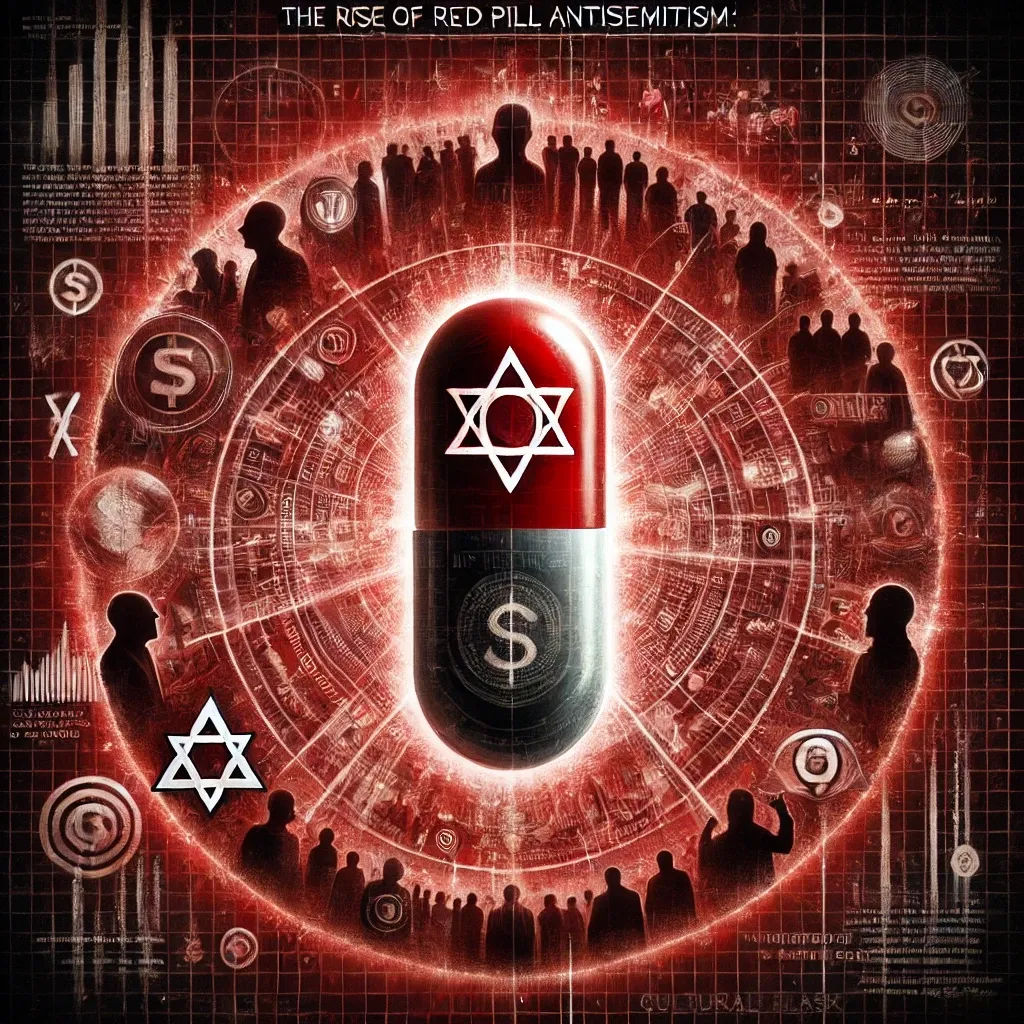

By Dr Tim Orr
In recent years, the rise of the so-called "Red Pill" movement has transformed from its roots as a backlash against third-wave feminism and progressive ideology to something far darker: a mainstream vehicle for antisemitism. Figures like Dan Bilzerian, Candace Owens, and others have used their platforms to propagate overt anti-Jewish conspiracies that borrow from age-old antisemitic tropes while masquerading as enlightened cultural criticism.
This alarming trend finds fertile ground in the current sociopolitical climate, where economic hardship, cultural turmoil, and distrust in mainstream institutions are at a high. To fully understand the rise of Red Pill antisemitism, we need to examine its roots, key players, and the dangerous implications it holds for our society.
The Red Pill Movement: A Brief Background
The Red Pill movement, inspired by the 1999 film The Matrix, began as a counter-narrative to what its adherents saw as the feminization of society and the suppression of traditional masculinity. Frustrated men, disillusioned with modern feminism, educational systems, and cultural narratives that branded masculinity as "toxic," found solace in this ideology.
On its face, the Red Pill critiques had some merit. Many men do face unique struggles in contemporary society, such as higher suicide rates, deaths of despair, and educational setbacks. However, the movement quickly devolved into something more insidious, championing unbridled male dominance, transactional relationships with women, and a rejection of any ethical or moral restraint. Figures like Andrew Tate epitomized this unbridled masculinity, openly aligning with Islam for its perceived reinforcement of patriarchal norms.
What began as a reaction to cultural excesses soon metastasized into a worldview that blames Jews—a classic scapegoat—for all societal woes.
The Conspiratorial Turn: Jews as the Scapegoat
The Red Pill movement’s conspiratorial turn was almost inevitable. It prides itself on offering “enlightenment” to those willing to see “the truth” behind society’s ills. Much like the interwar years in Nazi Germany, the movement claims to unmask a Jewish “cabal” that controls Washington, Hollywood, higher education, and the media. This antisemitic scapegoating is not new but has been reframed for the digital age.
For example, Dan Bilzerian, the former playboy and internet celebrity, recently appeared on Patrick Bet-David’s PBD podcast, where he openly accused Jews of parasitism, claiming they “provide no value” to America. He blamed Jews for controlling Hollywood, pushing diversity initiatives (DEI), and promoting “radical moral decay” through transgender ideology and critical race theory.
Candace Owens, another prominent figure, has tread a similar path. Her evolution from cultural commentator to one of the most vocal critics of Israel highlights this disturbing shift. Owens began by questioning Israel’s policies under the guise of “America First” isolationism, only to progress to overtly antisemitic rhetoric. She recently claimed that Jews manipulate the media and politics to suppress dissent and maintain control, echoing tropes of a secret Jewish cabal.
Both Owens and Bilzerian claim they are “just asking questions,” a tactic often used to shield their statements from criticism. However, their rhetoric reveals deep animosity toward Jews, far beyond political disagreements.
Key Players in Red Pill Antisemitism
Several individuals and platforms have amplified Red Pill antisemitism:
- Dan Bilzerian – Known for his hedonistic lifestyle and larger-than-life persona, Bilzerian’s newfound moral posture against Jews exposes the contradictions in his worldview. He blames Jews for everything from America’s foreign policy to cultural decay while dismissing Israel’s legitimate security concerns and its role as a strategic U.S. ally.
- Candace Owens – A former darling of the conservative movement, Owens gained fame through her “Red Pill Black” persona. Her criticisms of Israel have morphed into outright hostility toward Jews, claiming that Jewish influence corrupts America’s institutions.
- Tucker Carlson – While less explicit, Carlson has provided a platform for voices sympathetic to isolationism and critiques of Israel, which often veer into antisemitic undertones. His influence among conservative audiences has legitimized fringe ideas.
- Andrew Tate – Tate, a controversial figure within the Red Pill movement, aligned himself with Islam, citing its appeal to traditional masculinity. His admiration for Islam coincides with his disdain for Jews, further fueling antisemitic narratives.
Why is This Happening?
The resurgence of antisemitism within the Red Pill movement mirrors historical patterns. Like the interwar years in Germany, we live in a period marked by economic instability, political division, and cultural disillusionment. In such times, it is easy for opportunists to exploit public frustrations by pointing to a common enemy. Jews, historically scapegoated for societal crises, once again find themselves the target.
Additionally, the Red Pill movement’s rejection of moral restraint aligns with antisemitic conspiracies. It is a movement unmoored from Christian ethics, and without a higher moral framework, it justifies hatred toward Jews as righteous indignation. This narrative appeals to young men who feel disillusioned with modern culture but lack a healthy alternative to channel their frustrations.
The Dangers of Mainstreaming Antisemitism
What makes Red Pill antisemitism particularly dangerous is its reach. Figures like Bilzerian and Owens command large followings on social media and influential platforms like the PBD podcast. Their rhetoric, once confined to extremist corners of the internet, is now creeping into mainstream conservative and libertarian circles.
The comment sections on these interviews reveal the extent of the problem. Many young men, frustrated with the cultural left’s dominance, see Jews as the architects of their grievances. They adopt antisemitic conspiracies not out of ideological hatred but because these ideas appear to validate their experiences and offer a scapegoat.
A Call to Action: Speaking Truth to Lies
Christians, in particular, have a moral and religious duty to combat antisemitism. The Bible commands us to “bless the people of Israel” (Genesis 12:3) and to stand against hatred and falsehood. Antisemitism is not only a moral failure but also a rejection of truth—capital T Truth—which Christians are called to uphold.
We must resist the temptation to scapegoat any group for society’s challenges. It is intellectually lazy and morally reprehensible. While it is valid to critique policies or institutions, blaming Jews as a collective is not only wrong but historically catastrophic.
Conclusion: Learning from History
The rise of Red Pill antisemitism is a warning sign. The same societal conditions that gave rise to antisemitism in the 1920s and 30s are present today. Economic hardship, political polarization, and cultural disillusionment create fertile ground for these ideas to take root.
If we do not speak out against this growing trend, we risk repeating history’s darkest chapters. It is our responsibility—especially as Christians—to confront antisemitism wherever it emerges, whether on the left or the right. Our Jewish neighbors deserve our solidarity, and our integrity as a moral society depends on it.
Let us reject the lies and conspiracies that seek to divide us. Instead, let us pursue truth, justice, and love, as we are called to do.
References
Cohen, M. (2020). Antisemitism: A historical overview. Cambridge University Press.
Durie, M. (2010). The Third Choice: Islam, Dhimmitude and Freedom. Deror Books.
Friedman, R. (2017). The Roots of Antisemitism in the Modern World. Oxford University Press.
Lipstadt, D. (2019). Antisemitism: Here and now. Schocken Books.
Weinberg, D. E. (2022). The resurgence of global antisemitism. Routledge.
Wistrich, R. S. (2012). A lethal obsession: Antisemitism from antiquity to the global jihad. Random House.
